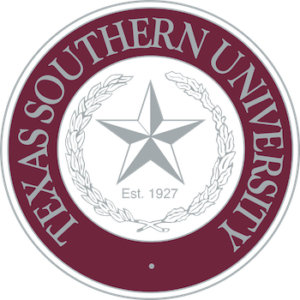
*Texas Southern University was founded on this date in 1927. It is a public historically black university (HBCU) in Houston, Texas.
The university is one of the nation's largest and most comprehensive HBCUs, with over 10,000 students enrolled and over 100 academic programs. It is a Thurgood Marshall College Fund member and is accredited by the Southern Association of Colleges and Schools. It is classified among "R2: Doctoral Universities High research activity."
In the early 20th century, the Houston Independent School District board resolved to establish junior colleges for each race, as the state was racially segregated in all public facilities. The resolution created Houston Junior College, which later became the University of Houston, and Houston Colored Junior College, which first held classes at Jack Yates High School during the evenings. The school's name was changed to Houston College for Negroes in 1934.
In February 1946, Heman Marion Sweatt, a Black man, applied to the University of Texas School of Law. He was denied admission because of race and filed suit in Sweatt v. Painter (1950). The state had no law school for African Americans. To avoid integrating the University of Texas Law School, the state of Texas made several offers to Heman Marion Sweatt to keep him from going to court. They offered to establish the Texas State University of Negroes, which would include a law school. Some Black leaders welcomed the idea of having another state-supported university in Texas. In contrast, many others felt the university was created solely to avoid the integration of the University of Texas and other white institutions.
Ultimately, they did not grant Sweatt a writ of mandamus to attend the University of Texas; the trial court granted a six-month continuance to allow the state time to create a law school for Blacks. As a result, the Fiftieth Texas Legislature passed Texas Senate Bill 140 on March 3, 1947, authorizing and funding the creation of Texas State University for Negroes as the first state university in Houston. The school was established to serve Blacks in Texas and offer them fields of study comparable to those available to white Texans. The state took over the Houston Independent School District (HISD)-run Houston College for Negroes as a basis for the new university. Houston College moved to the present site (adjacent to the University of Houston), which Hugh Roy Cullen donated.
It had one permanent building and an existing faculty and students. The new university taught "pharmacy, dentistry, arts and sciences, journalism, education, literature, law, medicine, and other professional courses." The legislature stipulated that "these courses shall be equivalent to those offered at other institutions of this type supported by the State of Texas." Given the differences in facilities and intangibles, such as the distance of the new school from Austin, the University of Texas School of Law, and other law students, the United States Supreme Court ruled the new facility did not satisfy "separate but equal" provisions. It ruled that Blacks must also be admitted to the University of Texas Law School at Austin.
In March 1960, Texas Southern University students organized Houston's first sit-in at the Weingarten's lunch counter. The success of their efforts inspired more sit-ins throughout the city, which, within months, led to the desegregation of many of Houston's public establishments. Today, a historical marker commissioned by the Texas Historical Commission stands on the property of the first sit-in to commemorate the courageous acts of those TSU students. It was designated on March 4, 2010, the fiftieth anniversary of that sit-in. On May 17, 1967, it was reported that students at TSU rioted on campus. When officers responded, thousands of shots were fired, and there were injuries on both sides, including the death of a police officer.
Nearly 500 students were arrested. No reports of looting, destruction of property, or resistance to any arrest were reported. Furthermore, the reports failed to mention the prior invasion of police officers on campus or the reports of students getting roughed up on campus. The police raid caused over $10,000 of damage, and over 3,000 shots were fired into the Lanier dormitory. There was little coverage that the five students charged with conspiracy and incitement of riot were all exonerated due to lack of evidence or that the police officer died not from student fire but the ricochet of Houston Police Department bullets.
Texas Southern University is an essential institution in Houston's Third Ward. Alvia Wardlaw of Cite: The Architecture + Design Review of Houston wrote that the university serves as "the cultural and community center of" the Third Ward area where it is located, in addition to being its university. The university also serves as a notable economic resource for Greater Houston, contributing over $500 million to the region's gross sales and directly and indirectly responsible for over 3,000 jobs.
A Democratic presidential debate occurred on September 12, 2019, in TSU's Health and Physical Education Arena. The university drew national attention in early 2020 when the Governor of Texas appointed a board of trustees to target the university's sitting president and changed its bylaws to allow the board to remove anyone employed by the university. Texas Southern University's intercollegiate sports teams, the Tigers, compete in NCAA Division I and the Southwestern Athletic Conference (SWAC). The university recruits nationwide for its Ocean of Soul marching band.